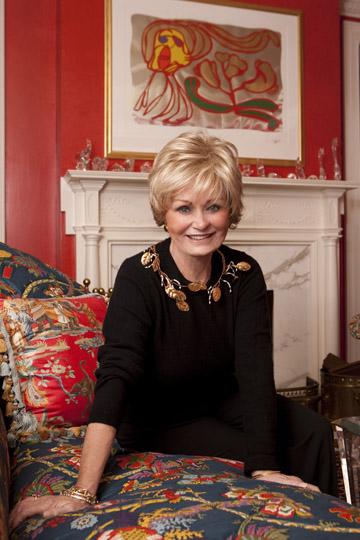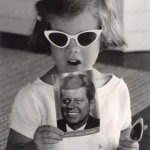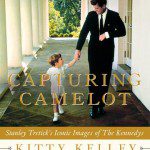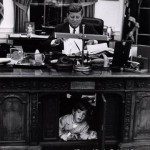The scene looked very familiar.
There she was, biographer Kitty Kelley on NBC’s “The Today Show,” managing to look elegant in black with pearls, blonde hair, while being interviewed about her latest book by current co-host Savannah Guthrie this Tuesday.
It looked familiar because Kelley writes big books about big people that generate controversy and buzz, people like the British Royal Family, the Bush family, Frank Sinatra, Nancy Reagan, Liz and Jackie Kennedy and Oprah Winfrey. Because of all that, it’s only natural that Kelly should be on a morning news show, right up there with the usual mix of the important issues of the day like the quickly mushrooming scandal over the startling resignation of CIA Director General David Petraeus and his mistress, alongside the presence of hunky movie star Bradley Cooper promoting a movie and the British boy rock group One Direction, filled the streets of still-reeling-from-Sandy New York with thousands of fans outside.
It was familiar, and then again not. Because the book wasn’t the kind of book Kelley is known for, big, onrushing bestsellers full of bombshell revelations, accompanied by threats of lawsuits and denials. It was something else entirely, a kind of love letter, a gift to his- tory, the nation and our own younger selves. This time the book is “Capturing Camelot,” subtitled “Stanley Tretick’s Iconic Images of the Kennedys,” authored by Kitty Kelley and published by Thomas Dunne Books and St. Martin’s Press. On the cover: President John F. Kennedy walking outside at the White House with his young son John F. Kennedy, Jr., part of a commemorative Look Magazine cover in December 1963, called “The President and His Son,” photographed by Tretick.
The photographs themselves were taken over a period of days in October 1963, only a month before the president’s assassination. They include the iconic, endlessly remembered shot of the two-and-a-half-year-old son of JFK snuggled under the Resolute Desk, while his father seems to be rifling through some papers, although you see the hint of a fatherly smile on his face.
“Stanley said, ‘When I shove off, that’s probably the only shot I’ll be remembered for,’ ” Kelley told us in an interview at her office in Georgetown.
“Stanley was my friend, my mentor, my buddy, he was brave and a pal ever since I met him,” she said. “When he suffered a series of strokes late in his life, I took care of him and had his power of attorney, and I was with him when he passed away in a home.
“See, this all came about with his trunk. Stanley had this trunk, and I asked him what was in it. He sort of grinned and said ‘nude pictures.’ He left it to me. After he passed away in 1999, my husband John said, ‘Aren’t you going to open it? Don’t you want to see what’s in it?” So, we opened it, and it was like a treasure chest of Kennedy memorabilia” There was a PT 109 tie clasp and a lucite box with a gold airplane that was given to those people who had flown with him on the Caroline during the harrowing, exciting and historic 1960 campaign for the presidency against Richard Nixon. There were signed pictures, campaign buttons and bumper stickers.”
Eventually, with all the material in the trunk and elsewhere—including an oral history made by Tretick for the Georgetown Public Library—Kelley decided to do the book. All her profits from it will go to the D.C. Public Library Foundation. It is, as noted, not a Kelley book in the sense of what anybody who knows only the Kelley books knows about her. In some ways, there are similarities—looking at the pictures of crowds reaching out wildly to touch JFK during the campaign and well as during RFK’s campaign. You can see the beginnings of the idea of political leaders as part of an emerging celebrity culture.
Kelley’s writing in this book puts the gifts she displayed in her best-selling biographies to good use. She moves the book along with her storytelling gifts. Her writing is the engine of the book, and it’s a thoroughbred engine of telling tales, illustrating and illustrative.
“He was my friend, he was a photographer, a cranky breed, sometimes,” he said. “Sometimes, he made me so mad I wouldn’t speak to him for days on end,” she said. In what she called a loving and intended good deed in “the sweet service of friendship,” he sent the Washington Post book critic who had panned her book on Elizabeth Taylor fishheads—mafia style—wrapped in elegant paper in stout defense of Kelley.
There was also the occasion when he worked with her on an interview with Frank Sinatra, Jr., who had whispered to her that he knew where Jimmy Hoffa was. “Here was Stanley, shooting like the pro he was, unobtrusively, when suddenly he jumped in and said ‘Well, out with it, man. What the hell happened to Hoffa?’ ” In the book, and in person, Kelley tells the story. “Sinatra reared back as if he’d been shot.” The upshot was that he bolted out of the interview because of Tretick’s shouting. She never got her answer, and Sinatra had denied ever doing the interview. “That’s where Stanley saved the day—he shot a picture of me with pencil and notebook, talking with Sinatra. It was the proof. But I was furious, my God, I was mad at Stanley.”
In her office, which is filled with her books and posters, a place that has a kind of quiet, gentle and genteel atmosphere, she obviously loves telling stories about her friend Stanley. In any conversation with Kelley, her love of Georgetown as place, idea and home also comes through—“Stanley when he came over said that’s the Brennan (Supreme Court Justice William Brennan) house. ‘It still is,’ I told him.”
This is, as she said, a kind of love letter, an homage to Tretick, a man with a craggedly handsome face and eager eyes which seem to fulfill legendary photographer Walker Evans’s admonition: “When you go out in the world, go out with hungry eyes.” When she talks about the book, about the Kennedys (and it should be remembered that one of her first subjects was Jackie Kennedy, herself), about the pictures in the trunk, old friends and losses, you get a real appreciation of the rich treasures of history that are “captured” in this book. It’s not just Camelot, frozen in warmth and energy, but ourselves over time.
When Kelley met Tretick, a veteran UPI and Look Magazine photographer in his day, she was working on a book about Elizabeth Taylor, and he apparently had some anecdotal information about Liz and Dick. There is a picture of them in the East Room of the White House in 1982, preened over by chandeliers, Kitty in curls, Stanley with big, black eyebrows, a “Hi, there” smile on his face.
A lot has changed just about everywhere you look. Kelley, in the process of chronicling uniquely and with great, heart-blasting originality the lives of the biggest celebrities, leaders and players in the world, became a celebrity herself, the object of prying eyes, and public resentments, a status she still seems not entirely comfortable with. She has always had courage—a quality she shared with the Korean veteran and marine Tretick and friends like the pugilist and actor Tom Quinn—under fire, but she has endured losses, like everyone else, and those uniquely hers.
It’s easy to tell she’s still in shaken mourning over the death of her second husband Jonathan E. Zucker, M.D., from a heart attack in late December 2011. “He was the love of my life,” she will tell you, and you could see that if you saw them out together. Singly, they were both impressive people with unique gifts and bearing— together, out and about as a couple they lit up a party, brightened up a room like a high-energy candle and flower setting.
The book has Kelley’s energetic writing. It brings to life not only Camelot but also the man who captured it with his lens. Tretick had a warm connection to the Kennedys which continued after JFK’s death through Bobby and Jackie. He had an exclusive connection through Look magazine.
In his last years, in which Kelley took care of him, she got John Kennedy, Jr., who was then editor of George Magazine and 37 years old, to sign a copy of the famous under-the-desk picture that she brought to his room. In July 1999, Tretick took has last breath with the television in his room showing images of the search for John Kennedy, Jr.’s body near Cape Cod. “Days later,” she writes, “John Kennedy, Jr., was buried at sea and Stanley’s ashes were placed in the Columbarium at Arlington National Cemetery not far from the Kennedy grave sites and the glow of the eternal flame.” Tretick was 77 when he died.
The book is also a loving ghost story—memories and losses are on display here. The book is dedicated to Kelley’s husband “who made dreams come true.” It is a pane to the gifts of Tretick, his work fully and richly on display. More than that, it is, of course, about “capturing Camelot,” the times of our lives, the days of glory for wire services, daily newspapers and weekly picture magazines like Look and Life, the Kennedys alive in the cold memories of November, in the streets of Georgetown.
In the end, “Capturing Camelot” is a gift book, a history book, a picture book with marvelous stories. Mostly, it’s a gift to all of us.
- Neshan Naltchayan
- Kitty Kelley | Philip Bermingham








